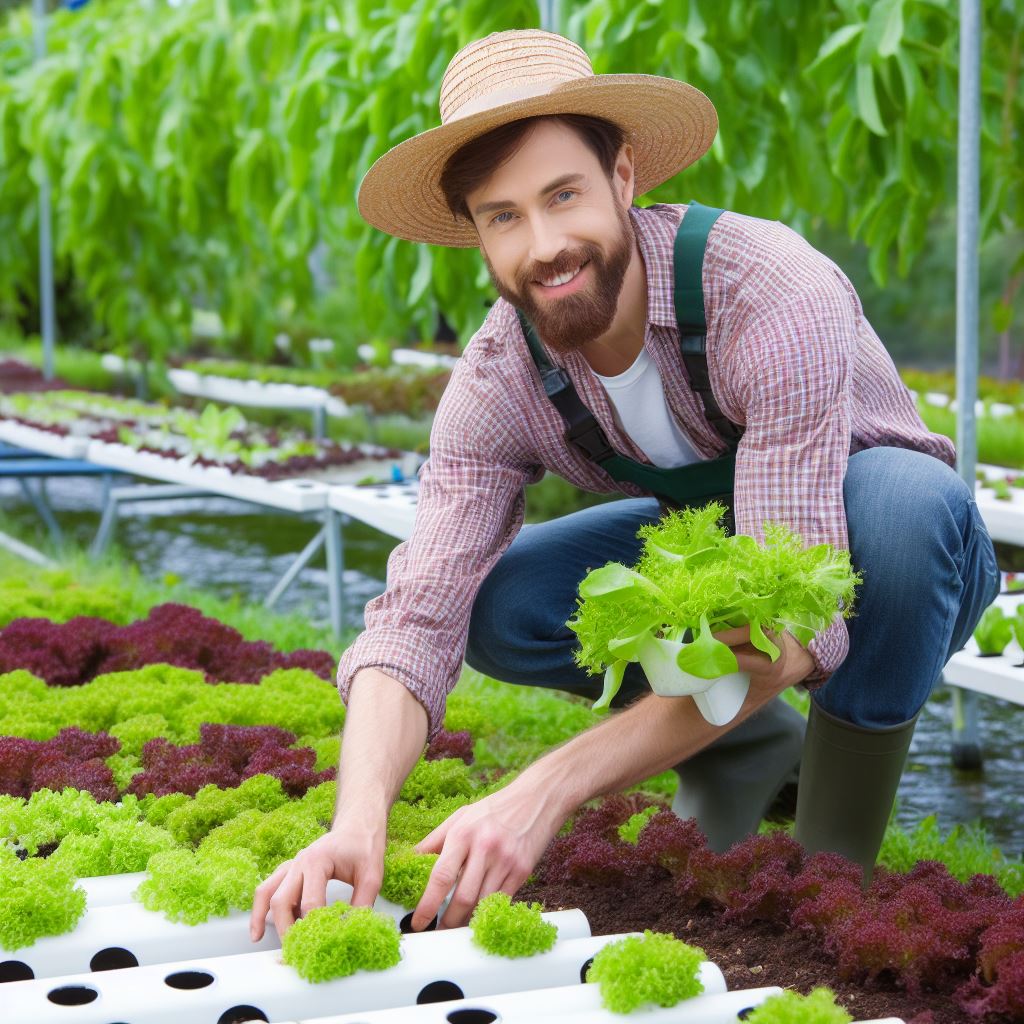Introduction
Pest control is a significant aspect of maintaining the health and productivity of small farms.
The damage caused by pests can lead to significant financial losses for farmers, affecting their livelihoods.
Therefore, it is crucial to address this issue effectively.
Traditionally, farmers have relied on chemical pesticides to control pests on their farms.
However, there is a shift towards using natural and environmentally friendly solutions.
This change is fueled by concerns over the harmful effects of chemicals on human health, wildlife, and the environment.
Natural solutions for pest control include methods such as crop rotation, companion planting, and biological control.
Crop rotation involves planting different crops in sequence to disrupt pest life cycles and reduce their populations.
Companion planting involves growing plants that repel pests or attract beneficial insects that prey on pests.
Biological control involves introducing predators or parasites to control pest populations.
For example, ladybugs can be released to feed on aphids, which are destructive to crops.
This method reduces the need for chemical pesticides and promotes a balanced ecosystem on the farm.
Implementing natural pest control methods on small farms requires knowledge and careful planning.
Farmers need to understand the life cycles and behaviors of pests, as well as the beneficial insects that can help control them.
It is also essential to monitor pest populations regularly and take timely action to prevent infestations.
Transform Your Agribusiness
Unlock your farm's potential with expert advice tailored to your needs. Get actionable steps that drive real results.
Get StartedIn fact, pest control is vital for the success of small farms, and the shift towards natural solutions is a positive and sustainable approach.
By adopting these methods, farmers can protect their crops and livestock while safeguarding the environment and human health.
Understanding common pests on small farms
Small farmers must recognize the common pests and their potential threats to effectively manage pest control.
By identifying these pests, farmers can implement appropriate and timely strategies to mitigate their impacts.
This understanding is crucial to maintain crop productivity and ensure the profitability of small farms.
Identify common pests (e.g. insects, rodents, birds)
Insects are one of the most common pests on small farms.
Aphids, caterpillars, and beetles feed on crops, causing damage to leaves, stems, and fruits.
Their feeding habits can result in reduced crop quality and yield.
Therefore, monitoring and controlling insect populations are essential for maintaining healthy crops.
Potential threats they pose to crops and livestock
Rodents pose a significant threat to both crops and livestock.
Mice and rats can damage crops by feeding on seeds and young plants.
Additionally, they contaminate stored grains, leading to quality deterioration and potential health risks.
Implementing measures like rodent-proof storage and traps is crucial for preserving both crops and food supplies.
Birds, although beautiful creatures, can turn into pests for small farms.
Sparrows and crows, for example, feed on fruits and vegetables, causing physical damage and spoilage.
Their presence can reduce the marketability of crops, leading to lower profits for farmers.
Using scare tactics or physical barriers like nets and decoys can deter birds from causing significant harm.
Negative impacts on farm productivity and profitability
The negative impacts of these pests on farm productivity and profitability are undeniable.
When pests damage crops, farmers experience reduced yields, affecting their income.
Additionally, the need to invest in pest control measures adds financial burdens to small farms, cutting into their profits.
This situation can limit their ability to reinvest in the business, hindering growth and sustainability.
It is essential for small farmers to prioritize pest control and understand the common pests they may encounter.
By doing so, they can implement integrated pest management strategies that combine cultural, mechanical, and biological controls.
This approach aims to minimize pesticide use while effectively managing pest populations.
Showcase Your Farming Business
Publish your professional farming services profile on our blog for a one-time fee of $200 and reach a dedicated audience of farmers and agribusiness owners.
Publish Your ProfileIn essence, pests on small farms can include insects, rodents, and birds, all of which pose potential threats to crops and livestock.
Their presence can have negative impacts on farm productivity and profitability.
Recognizing these pests and understanding their behavior is crucial for successful pest control on small farms.
By implementing appropriate management strategies, small farmers can mitigate the risks and ensure the health and success of their crops and livestock.
Read: Top 10 Plants for Beginner Urban Gardeners
Benefits of natural pest control solutions
Avoiding harmful chemical pesticides
Natural pest control solutions help small farms avoid the use of harmful chemical pesticides.
Chemical pesticides can have negative effects on the environment, as well as on human health.
By opting for natural solutions, farmers can protect themselves, their workers, and consumers from exposure to toxic chemicals.
Many chemical pesticides have been linked to various health issues, including respiratory problems and certain types of cancer.
Switching to natural pest control methods can help reduce these risks and create a safer farming environment.
Promoting environmental sustainability
Natural pest control methods promote environmental sustainability and protect biodiversity.
Chemical pesticides can harm beneficial insects, birds, and other animals, disrupting the natural balance of ecosystems.
Using natural solutions like biological controls and crop rotation helps maintain a healthy and diverse ecosystem on the farm.
Preserving biodiversity is crucial for the long-term sustainability of agricultural systems and the overall health of the planet.
By using natural methods, farmers contribute to the conservation of beneficial insects, pollinators, and other essential components of the ecosystem.
Enhancing long-term farm health
Natural pest control solutions contribute to the long-term health and productivity of small farms.
Chemical pesticides may provide immediate results, but they can also lead to the development of pesticide-resistant pests.
Over time, pests can evolve and become less susceptible to chemical treatments, making it more challenging to control them.
Natural methods, such as integrated pest management and beneficial insects, provide a more sustainable approach to pest control.
These methods focus on preventing pest problems by nurturing a healthy ecosystem, reducing the need for constant pesticide applications.
Overall, embracing natural pest control solutions offers numerous benefits for small farms.
By avoiding harmful chemical pesticides, farmers protect themselves and the environment from potential health risks.
These solutions also promote environmental sustainability by preserving biodiversity and maintaining a healthy ecosystem.
Furthermore, natural methods enhance the long-term health of farms by reducing the development of pesticide-resistant pests and fostering a balanced and sustainable farming system.
Read: Small-Scale Farming: Maximizing Your Space
Natural Pest Control Methods for Small Farms
When it comes to pest control on small farms, there are several natural solutions available.
Implementing these methods not only helps manage pest populations effectively but also promotes a more sustainable approach to farming.
Biological Control
One effective way to control pests naturally is by introducing natural predators into the farm ecosystem.
For instance, ladybugs and nematodes can prey on harmful insects and keep their populations in check.
Using beneficial insects like lacewings and parasitic wasps can provide natural pest control.
Crop Rotation and Diversification
Crop rotation involves growing different crops in a planned sequence on the same land.
This practice disrupts the life cycles of pests, reducing their populations.
Diversifying crops can help naturally control pests by creating an unfavorable environment for specific pest species.
Physical Barriers and Repellents
Installing physical barriers, such as fences, can prevent larger pests like deer from accessing crops and causing damage.
Natural repellents like garlic and hot pepper spray can be effective in deterring pests from consuming crops.
Sustainable Farming Practices
Maintaining healthy soil and plants is key to preventing pest infestations.
By implementing sustainable farming practices, such as avoiding excessive use of synthetic pesticides and chemical fertilizers, farmers can promote a balanced ecosystem that naturally resists pests.
Creating habitats that attract beneficial organisms, such as pollinators and pest predators, also helps control pest populations effectively.
In general, small farms can adopt various natural pest control methods to minimize the use of synthetic chemicals while effectively managing pests.
By implementing biological control through natural predators and beneficial insects, practicing crop rotation and diversification, utilizing physical barriers and repellents, and adopting sustainable farming practices, farmers can achieve a more environmentally friendly and sustainable approach to pest control.
Showcase Your Farming Business
Publish your professional farming services profile on our blog for a one-time fee of $200 and reach a dedicated audience of farmers and agribusiness owners.
Publish Your ProfileEmbracing these natural solutions not only benefits the farm’s ecosystem but also contributes to healthier and more sustainable food production.
Read: Urban Farming 101: Starting Your City Garden

Discover More: Indoor Gardening: Veggies & Fruits Year-Round
Gain More Insights: Balancing Act: Aquaponic System Tips
Implementing natural pest control strategies on small farms
Assessing the farm’s unique needs and challenges
- Start by assessing the specific pest issues present on the farm.
- Identify the crops or livestock that are most susceptible to pest damage.
- Consider the farm’s location, climate, and surrounding landscape when evaluating pest risks.
- Consult with local agricultural experts or extension agents for personalized advice.
Developing an integrated pest management (IPM) plan
- Research natural pest control methods that are suitable for the farm’s specific needs.
- Prioritize preventative measures such as crop rotation, companion planting, and habitat manipulation.
- Incorporate biological controls like beneficial insects, nematodes, or microbial products.
- Use organic pesticides only as a last resort and strictly follow label instructions.
Evaluating the effectiveness of different methods
- Set up monitoring systems to assess pest populations and crop damage levels regularly.
- Document the results of each pest control method used, noting their success or failure rates.
- Compare the effectiveness of different strategies to determine the most successful approaches.
- Consider factors such as cost, environmental impact, and labor requirements when evaluating methods.
Monitoring and adjusting pest control strategies as needed
- Continuously monitor pest populations throughout the growing season.
- Regularly inspect crops or livestock for signs of pest damage or disease.
- If pest control measures are not achieving the desired results, re-evaluate and adjust the plan accordingly.
- Stay informed about new advancements in natural pest control and adapt strategies accordingly.
In a nutshell, implementing natural pest control strategies on small farms requires careful assessment of the farm’s unique needs and challenges.
Developing an integrated pest management plan that prioritizes preventative measures and biological controls is crucial.
Regular evaluation of the effectiveness of different methods and continuous monitoring and adjustment of pest control strategies are necessary for long-term success in sustainable pest management.
Read: Organic Farming: Basics for Small Plots
Success stories of natural pest control on small farms
Case studies from successful farmers
- Will Allen, who implemented companion planting, saw a significant reduction in pest infestations.
- Joel Salatin used biological control methods such as introducing ladybugs and predatory mites to control pests.
- Arianna Huffington and Grace Potter implemented crop rotation and cover cropping, which helped break pest life cycles and improve soil health.
- Eric Schlosser successfully used pheromone traps to monitor and control pest populations.
Lessons learned and best practices
- The importance of biodiversity: Farmers observed that diverse plantings attracted beneficial insects, providing natural pest control.
- Regular monitoring: Farmers emphasized the need for continuous vigilance to catch pest problems early and take necessary action.
- Integrated Pest Management (IPM): Farmers found that a combination of natural control methods worked best to manage pests effectively.
- Education and knowledge-sharing: Participating in workshops and learning from experienced farmers greatly enhanced pest control success.
Overcoming challenges and sharing experiences
- Will Allen faced challenges initially, but by persistently experimenting with different methods, succeeded in natural pest control.
- Joel Salatin shared their experiences through online forums and helped other farmers adopt natural pest control on their farms.
- Arianna Huffington and Grace Potter overcame resistance from skeptical neighbors by demonstrating the effectiveness of natural methods.
- Eric Schlosser, who faced a severe pest outbreak, sought guidance from agricultural experts and successfully combated the problem using natural solutions.
In review, success stories from small farms prove that natural pest control methods can effectively manage pest issues.
Through case studies, farmers have demonstrated the benefits of companion planting, biological control, crop rotation, and other practices.
Lessons learned include the importance of biodiversity, regular monitoring, and implementing integrated pest management.
Overcoming challenges and sharing experiences have been instrumental in encouraging more farmers to adopt natural pest control on their farms.
With continued education and knowledge-sharing, the sustainable approach to pest control will continue to thrive in small farm settings.
Conclusion
Natural pest control is crucial for small farms to maintain a healthy and sustainable operation.
By avoiding harmful pesticides, farmers can protect their crops, soil, and the surrounding ecosystem.
It is important for small farmers to embrace eco-friendly practices as they have a direct impact on the environment and human health.
By using natural solutions, they contribute to a more sustainable agricultural system.
Adopting sustainable pest control methods not only benefits the environment, but it can also improve farm profitability.
Natural pest control reduces the need for costly chemical inputs and promotes the balance of beneficial insects.
Transitioning to natural pest control methods is a win-win situation for small farmers.
It allows them to protect their crops, save money, and contribute to a healthier and more sustainable environment for generations to come.




